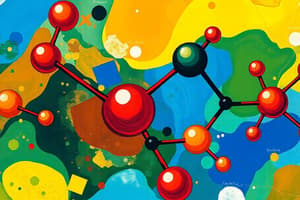Podcast
Questions and Answers
Carbohydrates, lipids, and proteins are classified as
Carbohydrates, lipids, and proteins are classified as
- Acids
- Bases
- Inorganic molecules
- Salts
- Organic molecules (correct)
A functional group is best described as reoccurring clusters of
A functional group is best described as reoccurring clusters of
- Elements that form at high pH and who can successfully resist the action of buffers
- Atoms that form the main reactive area for a particular compound (correct)
- Amino acids in a globular protein such as hemoglobin, immunoglobulins, and albumins
- Atoms that function in the body even if temperatures and pH reach extreme values
- Elements that occur in a salt and that can neither be hydrolyzed nor dehydrated
Artificial sweeteners
Artificial sweeteners
- Are always some form of carbohydrate
- Are inorganic sugar substitutes
- Provide the same number of calories as an equivalent amount of sucrose
- Are usually not broken down by the body (correct)
- Are naturally similar to sugars
Fructose is
Fructose is
Molecules that have the same molecular formula but different structural formulas are called
Molecules that have the same molecular formula but different structural formulas are called
The most important metabolic fuel molecule in the body is
The most important metabolic fuel molecule in the body is
A polysaccharide that is formed in liver and muscle cells to store glucose is
A polysaccharide that is formed in liver and muscle cells to store glucose is
The group of organic compounds containing carbon, hydrogen, and oxygen in a near 1:2:1 ratio is defined as a
The group of organic compounds containing carbon, hydrogen, and oxygen in a near 1:2:1 ratio is defined as a
An example of an organic substance is
An example of an organic substance is
Carbohydrate molecules
Carbohydrate molecules
When two monosaccharides undergo a dehydration synthesis,
When two monosaccharides undergo a dehydration synthesis,
To bond two monomers together, a molecule of water must be ________ to/from monomers. This process is called ________.
To bond two monomers together, a molecule of water must be ________ to/from monomers. This process is called ________.
Lipids
Lipids
Alaska Natives have a lower incidence of heart disease even though their diets are high in fat and cholesterol. This may be due to the large amount of ________ in their diets.
Alaska Natives have a lower incidence of heart disease even though their diets are high in fat and cholesterol. This may be due to the large amount of ________ in their diets.
Which of the following is/are needed to form a triglyceride molecule?
Which of the following is/are needed to form a triglyceride molecule?
A shortage of steroids in the body would result in a shortage of
A shortage of steroids in the body would result in a shortage of
Most of the fat found in the human body is in the form of
Most of the fat found in the human body is in the form of
Lipids that are produced by nearly every tissue in the body and act as local regulators are the
Lipids that are produced by nearly every tissue in the body and act as local regulators are the
Cholesterol, phospholipids, and glycolipids are examples of
Cholesterol, phospholipids, and glycolipids are examples of
A fatty acid with no double bonds between carbon atoms is
A fatty acid with no double bonds between carbon atoms is
Many lipids are composed of fatty acids and
Many lipids are composed of fatty acids and
The monomers of protein are
The monomers of protein are
Substrate molecules bind to enzymes at the ________ sites.
Substrate molecules bind to enzymes at the ________ sites.
The term ________ refers to certain amino acids, which can have both a positive charge and a negative charge.
The term ________ refers to certain amino acids, which can have both a positive charge and a negative charge.
You would expect a peptide bond to link
You would expect a peptide bond to link
Each amino acid differs from another in the
Each amino acid differs from another in the
The term ________ means each enzyme catalyzes only one type of reaction.
The term ________ means each enzyme catalyzes only one type of reaction.
A side chain on an amino acid is sometimes called
A side chain on an amino acid is sometimes called
The alpha-helix and beta sheet are examples of ________ protein structure.
The alpha-helix and beta sheet are examples of ________ protein structure.
Interaction between individual polypeptide chains to form a protein complex is ________ structure.
Interaction between individual polypeptide chains to form a protein complex is ________ structure.
Glycoproteins and proteoglycans are combinations of amino acids and
Glycoproteins and proteoglycans are combinations of amino acids and
Which of the following is the symbol for an amino group?
Which of the following is the symbol for an amino group?
The maximum rate of an enzyme reaction
The maximum rate of an enzyme reaction
How would the lack of a cofactor for an enzyme affect that enzyme's function?
How would the lack of a cofactor for an enzyme affect that enzyme's function?
Identify the correct statement regarding the process of denaturation.
Identify the correct statement regarding the process of denaturation.
Which of the following are organic substances?
Which of the following are organic substances?
Molecules that store and process genetic information are the
Molecules that store and process genetic information are the
An amino acid is to a protein as a ________ is to a nucleic acid.
An amino acid is to a protein as a ________ is to a nucleic acid.
A nucleotide consists of a
A nucleotide consists of a
According to the rules of complementary base pairing in nucleic acids, cytosine would pair with the base
According to the rules of complementary base pairing in nucleic acids, cytosine would pair with the base
Adenine and guanine are
Adenine and guanine are
The structure of RNA differs from DNA in that
The structure of RNA differs from DNA in that
The most abundant high-energy compound in cells is
The most abundant high-energy compound in cells is
A high-energy bond in ATP is present between
A high-energy bond in ATP is present between
The phosphorylation of adenosine forms
The phosphorylation of adenosine forms
Identify the product formed from the phosphorylation of ADP.
Identify the product formed from the phosphorylation of ADP.
AMP + P →
AMP + P →
All fatty acids contain a functional group at one end called the ________ acid group.
All fatty acids contain a functional group at one end called the ________ acid group.
Individual steroids differ in the ________ attached to the carbon rings.
Individual steroids differ in the ________ attached to the carbon rings.
Molecules with two fatty acid chains and a phosphate group that form biological membranes are called
Molecules with two fatty acid chains and a phosphate group that form biological membranes are called
In water, phospholipids tend to form tiny droplets with hydrophobic tails buried inside called
In water, phospholipids tend to form tiny droplets with hydrophobic tails buried inside called
The molecule DNA contains a five-carbon sugar called
The molecule DNA contains a five-carbon sugar called
The three structural components of a nucleotide are a pentose, a phosphate group, and a ________ base.
The three structural components of a nucleotide are a pentose, a phosphate group, and a ________ base.
The purines found in DNA are ________ and guanine.
The purines found in DNA are ________ and guanine.
The pyrimidine bases found in DNA are ________ and cytosine.
The pyrimidine bases found in DNA are ________ and cytosine.
A(n) ________ bond is a covalent bond that stores an unusually large amount of energy.
A(n) ________ bond is a covalent bond that stores an unusually large amount of energy.
In the process of ________ a phosphate group is transferred to a molecule.
In the process of ________ a phosphate group is transferred to a molecule.
The hydrolysis of ATP yields ADP, phosphate ion, and
The hydrolysis of ATP yields ADP, phosphate ion, and
Flashcards are hidden until you start studying
Study Notes
Organic Molecules
- Carbohydrates, lipids, and proteins are classified as organic molecules.
- Organic compounds are characterized by the presence of carbon, hydrogen, and oxygen.
Functional Groups
- Functional groups are clusters of atoms capable of participating in chemical reactions, making them the main reactive areas in compounds.
Artificial Sweeteners
- Unlike sugars, artificial sweeteners are usually not broken down by the body and provide zero or fewer calories than sucrose.
Carbohydrates
- Fructose is a hexose, an isomer of glucose, and part of the carbohydrate group.
- Glycogen, a polysaccharide, functions as glucose storage in liver and muscle cells.
- Carbohydrates are the body's most readily available source of energy, composed primarily of C, H, and O in a 1:2:1 ratio.
Molecular Structures
- Isomers are molecules with the same molecular formula but different structural formulas.
- Monosaccharides undergo dehydration synthesis to form disaccharides.
Lipids
- Lipids, including triglycerides and phospholipids, form essential structures in cells, provide energy reserves, and help regulate body temperature.
- Most body fat is stored as triglycerides.
- Omega-3 fatty acids, abundant in Alaska Natives’ diets, may contribute to lower heart disease rates.
Enzymes and Proteins
- Proteins are made of amino acids; they exhibit high specificity, catalyzing only one type of reaction.
- Enzymes interact with substrates at active sites and require cofactors to function effectively.
- Denaturation results in the loss of protein structure due to factors like extreme pH changes or temperature.
Nucleic Acids
- Nucleic acids (DNA and RNA) are responsible for storing and processing genetic information, with DNA containing deoxyribose sugar.
- Nucleotides, the building blocks of nucleic acids, consist of a five-carbon sugar, a phosphate group, and a nitrogenous base.
Base Pairing in Nucleic Acids
- In nucleic acids, complementary base pairing occurs: cytosine pairs with guanine and adenine pairs with thymine (in DNA) or uracil (in RNA).
ATP and Energy
- Adenosine triphosphate (ATP) is the most abundant high-energy compound in cells, with high-energy bonds between phosphate groups storing energy.
- The hydrolysis of ATP provides energy necessary for biological processes.
Fatty Acids
- Fatty acids have a carboxylic acid group and may be saturated (with no double bonds) or unsaturated (with one or more double bonds).
- Phospholipids, essential for biological membranes, consist of two fatty acid chains and a phosphate group.
Protein Structures
- Proteins exhibit different levels of structure: primary, secondary (alpha-helix and beta-sheet), tertiary, and quaternary structures, with quaternary structure involving the interaction of multiple polypeptide chains.
Biological Membranes
- Phospholipids form micelles in water, with hydrophobic tails hidden inside, crucial for constructing cell membranes.
High-Energy Compounds
- Phosphorylation is a key process involving the transfer of a phosphate group to form energy-carrying molecules like ADP and AMP from ATP.
Studying That Suits You
Use AI to generate personalized quizzes and flashcards to suit your learning preferences.




